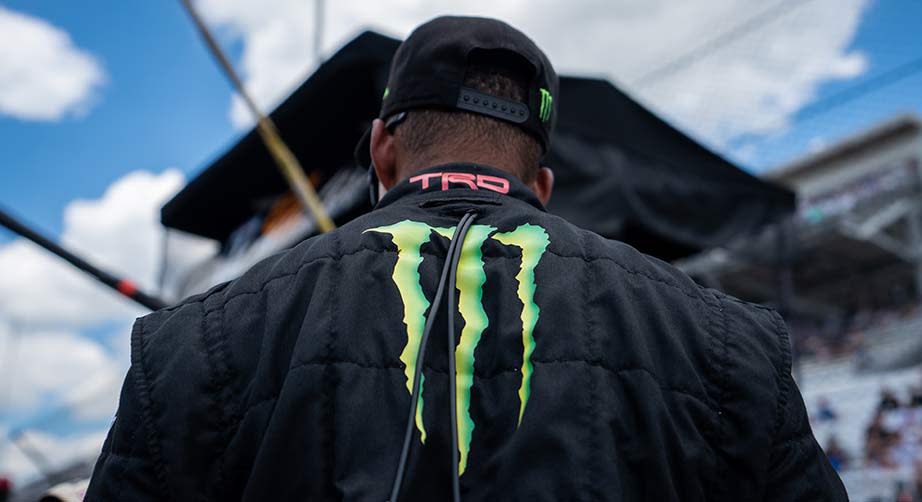Hot one: The advancements and safety of NASCAR fire suits beat the heat
NASCAR fire suits are hot off the presses and headed straight to the runway … or, more specifically, to pit road. The suits not only display the teams’ well-appreciated sponsors but also protect pit crew members and drivers from the extreme heat and possible fires.
Just like any sport, team members have a mandatory uniform and protection standard. NASCAR fire suits are made with Nomex, a flexible fiber developed by DuPont, that protects up to 1,000-degree heat. But recent advances have helped these uniforms with mobility and in keeping crew and drivers cooler in the summer months
“There’s a lot of things going on over the wall. You know, you’ve got lug nuts going everywhere, used to but now you‘ve got one and any fall down, things like that,” Chris Burkey, Joe Gibbs Racing pit crew coach, told NASCAR.com. “It is added protection like football, you know, they (fire suits) are hot, but obviously the most important part of it, it keeps them safe in the event of a fire.”
MORE: NASCAR TV schedule | Michigan weekend schedule
But these suits were not always as protective as they are now. In the 1950s, there were no fire suits, mandated gloves, or helmets. The fabric was thin and resembled everyday clothes, that is until NASCAR Hall of Famer Tim Flock became one of the first drivers to wear a fire-retardant jumpsuit.
A recent experience with the protective power of fire suits came from Justin Fiedler, former tire charger for Erik Jones’ No. 43, sharing his helmet cam footage from Nashville Superspeedway on social media.
Here's the stop. The detents on the left side did not release (again) and I was already on the trigger. Caused a few sparks. Sparks+fuel=fire. We did come back and change the LR the next lap. I apologized to Jones on the plane for setting his race car on fire. pic.twitter.com/20ShlzYB38
— Justin Fiedler (@Justin_Fiedler) June 27, 2022
“Fire suits are not necessarily completely fireproof,” Fiedler said. “You know they’re not going to protect you from it for a long period of time; what fire suits and fireproof underwear really do is just to give you time to get out of it. So, knowing that, if I need a second or a couple of seconds to finish up the job, I’m not concerned about staying.”
Fiedler is currently in his 16th season with the sport and says he‘s experienced countless pit stops across all three NASCAR series, but only four fires. He says the odds of extreme fires from the race cars are relatively low and that having the extra layers of protection comes as second nature.
“Knowing that I have all of the equipment on, you obviously are aware of it. It’s hot,” Fiedler said. “But I don’t worry necessarily about getting burned. You know, your suit will get singed, and maybe your knee pads or something like that will get some burn marks. But the fires that I’ve been in, I was not concerned in any way, shape or form about actually myself getting burned at this point.”

Throughout the years NASCAR has made it a point to require drivers and pit members to have SFI Foundation-approved suits, footwear, helmet, gloves, and fire-resistant underwear.
Although there‘s been a drastic change from early stock-car racing to today’s Next Gen race car, Burkey as a pit coach has seen advancement in the protective gear that has improved performance in pit crews.
“Even though the fire suits are kind of clunky and kind of heavy, they have made advancements in the materials to make them lighter, which is obviously a good thing for the guys,” Burkey said. “They like them lighter, more flexible and the guys can also do alterations.” All approved and certified, of course.
MORE: Evolution of fire suits in NASCAR
As DuPont and NASCAR continue to make advancements, Fiedler and Burkey say they hope the suits can offer more cooling technology, especially as the racing season peaks in the summer with 90-degree-plus temperatures. While pit crew members complete 12-second and under pit stops — all of this can cause heat exhaustion to the body.
“One thing the guys got to do, especially on a day like today, is hydrate. You know, we talk about hydration on Tuesday of the week. We just can’t do it today,” said Burkey. “We really talk about hydration because you will lose a little bit of weight just like a driver. … It is hard on them, so the hydration is a big part of it.”
Fiedler echoes Burkey and says he does “as much as I can through the week to be prepared for the weekend.” That in mind, he practices in his full fire suit get-up to have the same feeling as race day at practice.
“Obviously if it’s nice and cool outside and you’re not sweating, your fire suit is going to feel different and fit differently than if it’s a super-hot day and you’re sweating,” said Fiedler “… I’ve got two pairs of knee pads, you know, your knee pads kind of move around during stops and your gloves feel different and all of that stuff.”
“I want to sweat during practice so I can have those same feelings of what that’s going to be like at the race track, just to try to mimic things as much as you can.”

